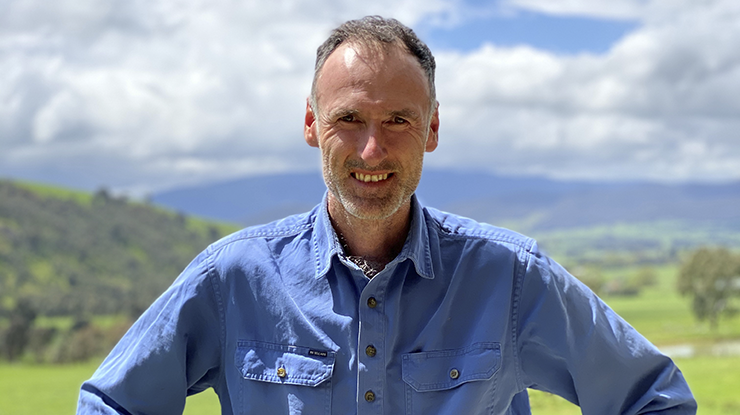
Caring for the environment is a top priority for Victorian beef producer, Julian Carroll, and it hasn't come at the cost of his herd's productivity.
Julian and his family operate an Angus seedstock business, Stellar Livestock, alongside a commercial herd at Mudgegonga.
The business has consistently focused on genetics for many years, to breed bulls for maternal efficiency and carcase merit, and produce commercial steers for the high marbling feedlot market.
In recent years, however, sustainability has also come to the fore.
"We really started to invest in this area when Dad handed over the reins to the business around 10 years ago," Julian said.
"I started repairing riparian zones, putting in shelter belts and other work to build our natural capital on-farm."
Creating a carbon account
When given the chance to create a carbon account for his business through Agriculture Victoria's Livestock Farm Monitor Project (LFMP), Julian took the leap to investigate the potential benefits of tracking emissions produced and carbon sequestered on-farm.
"I was always fascinated by the developing conversation around carbon accounting, and we were presented with a very easy path to carbon accounting through LFMP," Julian said.
"Agriculture Victoria had the foresight to realise the bulk of the farm data required for carbon accounting is the same data that needs to be collected for business benchmarking.
"They just had to ask me three more questions about the area, age and type of trees we had on-farm, and then we had a carbon account as well as an understanding of our business's performance."
Benchmarking benefits
Creating a carbon account while benchmarking his business is something Julian recommends other producers explore to maximise the benefits to their enterprise.
"Carbon accounting can be more than purely just figuring out your carbon intensity – there's so many benefits from the business benchmarking you can do alongside it.
"I can watch how our business performance changes from year to year, assess some of the aspects of my business I'm considering making changes in, and compare the business to other similar businesses in the area."
Capitalising on carbon
By creating a carbon account, Julian also hopes to stay ahead of consumer and market demands around sustainability.
"If there's an opportunity to turn our carbon position into a market advantage, we'll be set," Julian said.
"In the coming years, I expect producers will need to account for the carbon that went into producing many of the livestock sold direct to brand owners."
While the process of creating a carbon account can be daunting at first, Julian said it can be straightforward with solid systems for collecting farm data.
"The first time you do it is the worst time, as you're learning what data you need to collect and you've got to look in many different places to get it together," he said.
"By the time you've done it a few times, you actually have a good system in place to track all your data."
Keeping track
Julian looks to software as the solution for collecting the data needed to benchmark his business and update its carbon account.
"To create and maintain our carbon account, we need to provide a pretty detailed breakdown of all of our livestock sales, alongside changes to our inventory and inputs," Julian said.
His record-keeping process is:
- Details of cattle sold (live weight, sale value and marketing component cost) is entered into a spreadsheet.
- This spreadsheet is then used down the track for benchmarking and carbon accounting.
- Other inventory, such as fodder at the start versus fodder at the end of the financial year, is similarly recorded.
Facing the future
While Julian expects there to be challenges along the way to lowering his carbon intensity on-farm, he recommends producers create a carbon account as a solid first step towards bolstering the sustainability of their business in the long term.
"It's great that the industry has made a commitment to being carbon neutral in 2030," Julian said.
"For us, we're most excited about using carbon storage on-farm to our advantage.
"There's so many benefits to building natural capital on a farm, from boosting the health of waterways to providing shelter for cattle and sheep – and these remain the best outcomes from doing environmental work on your farm."
LESSONS LEARNT
|
Creating a carbon account: a checklistCollect data on your:
|
Carbon accounting toolsCalculator Together with the University of Melbourne and Integrity Ag and Environment, MLA has developed the Sheep & Beef Greenhouse Gas Accounting Framework (SB-GAF). This free tool calculates emissions from livestock inventory and major purchased farm inputs, as well as total carbon sequestered in trees on farm. To calculate a value for carbon stored in the feedbase and in soils – and to include it in your SB-GAF – producers can access the free Full Carbon Accounting Model (FullCAM) tool. Dedicated carbon accounting tools have also been developed for goat producers and feedlot operators by the University of Melbourne. Start creating your carbon account by visiting the Greenhouse accounting Frameworks (GAF) for Australian Primary Industries page. eLearning MLA's has released a series of carbon management eLearning modules to empower producers with the key knowledge required to make decisions around carbon farming and improving their carbon performance on-farm. The current modules in the series are titled 'Carbon 101', 'Measuring your own emissions' and 'Carbon sense'. To learn more about MLA's e-Learning modules visit their Carbon Training Packages |






